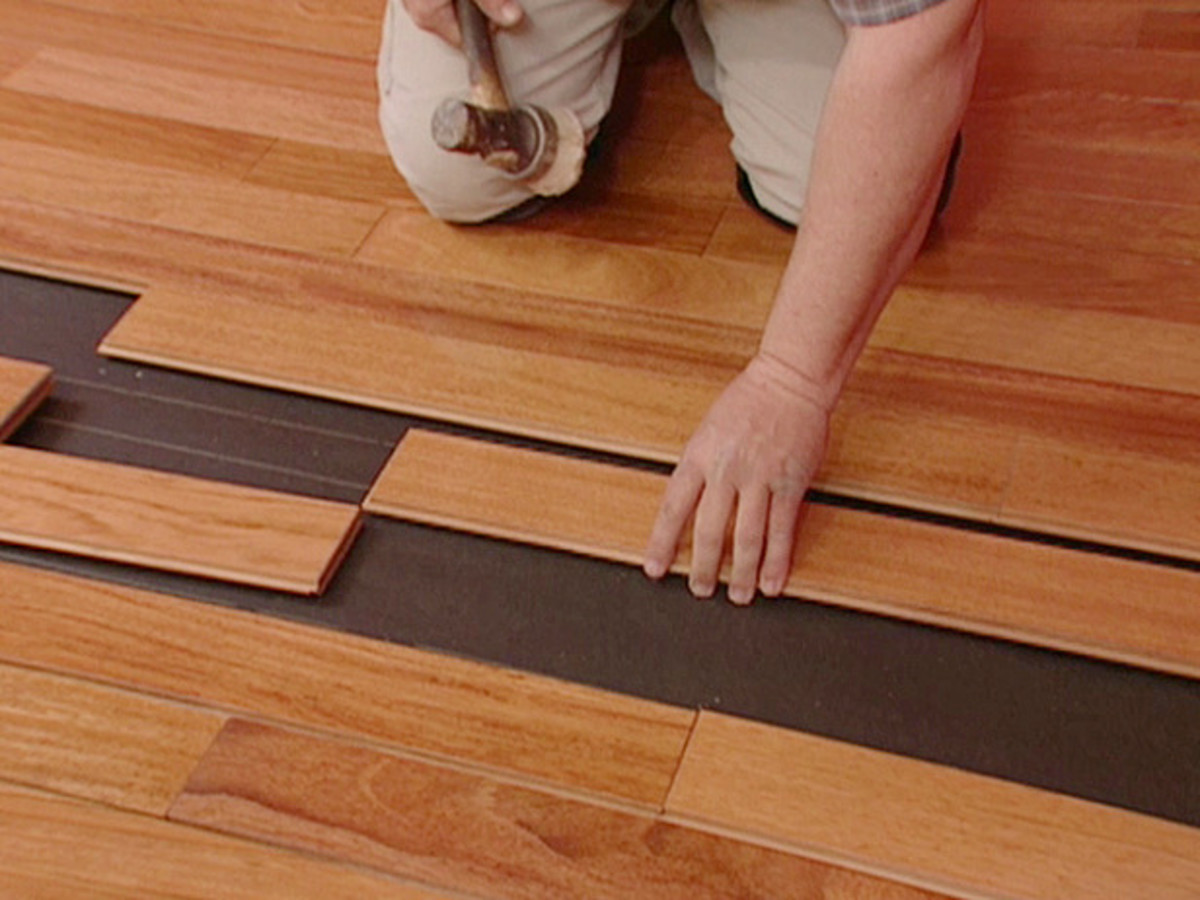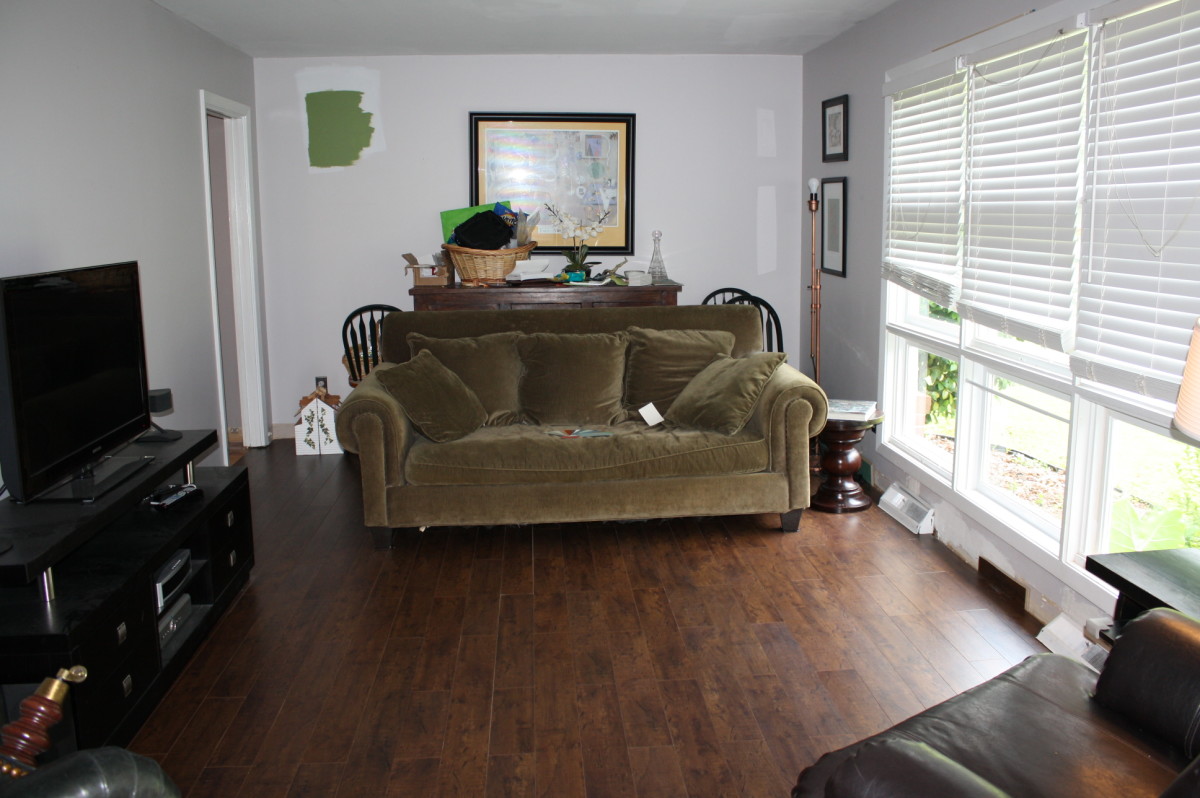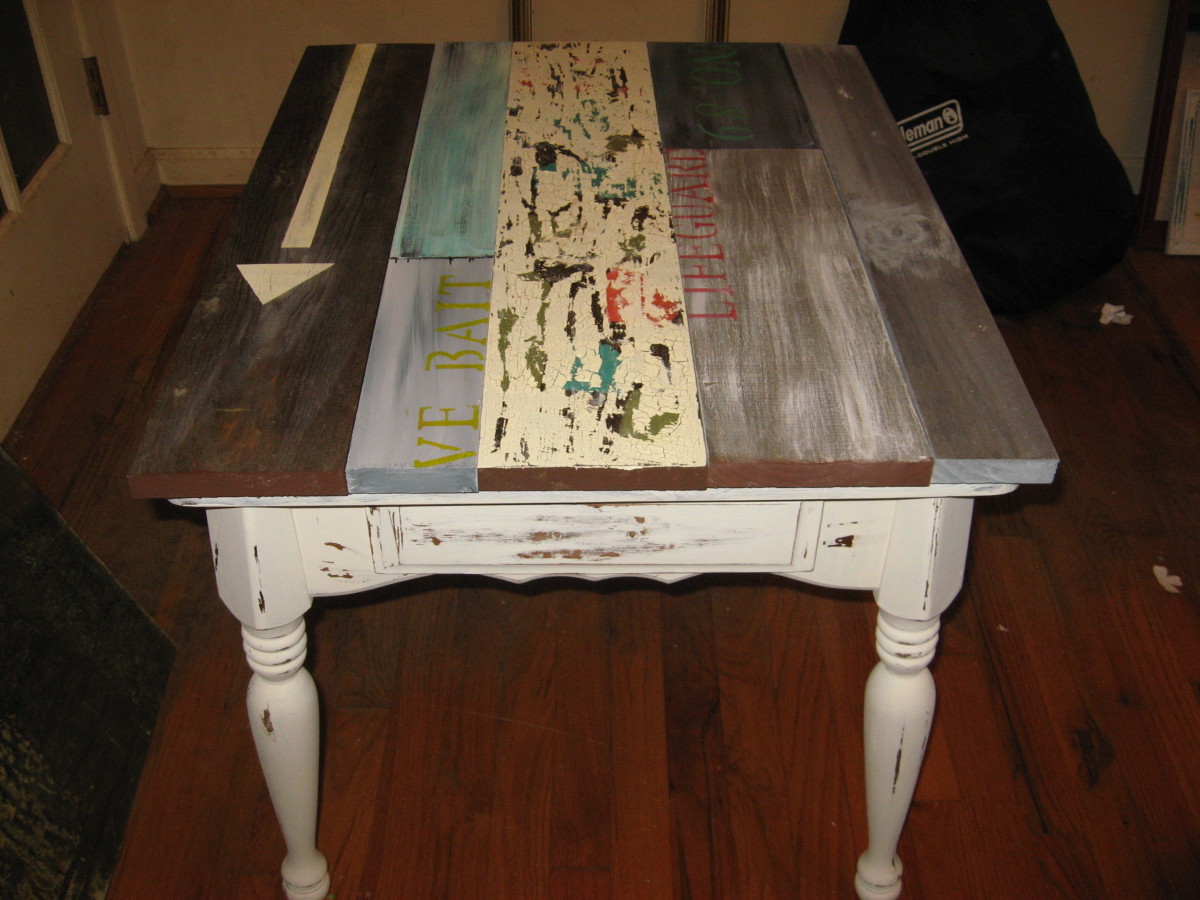Engineered Wood Floor Installation
Introduction
My aim is to have all my rooms either laminate or wooden floors. I suffer from a dust allergy. Carpets I can live with, but even with regular vacuuming, they still harbour dust and dust mites. All the dust and dirt remains on top of a hard floor, so it just needs to be either mopped or vacuumed.
This describes the floating method. There are 2 other methods - Glue down or nail down.
The Almost Final Result
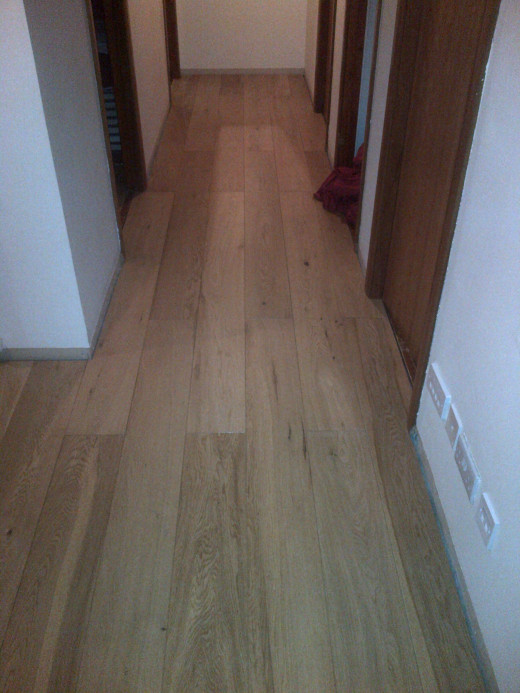
Before Picture
The room I was flooring was my hallway. It had a carpet it in it which originally came with the house when it was bought some years ago. The carpet was an olive green colour, plus there were patches where it had been repaired, badly.
Before Picture
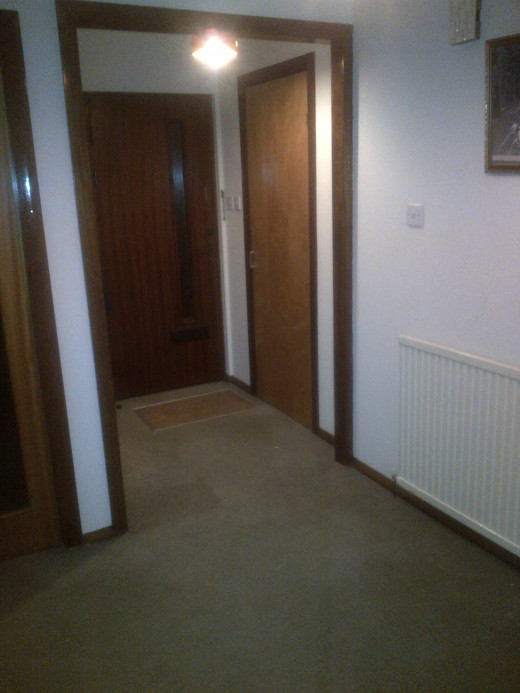
Cautionary Notes
Laying flooring is a physically demanding task. It is highly labour intensive. If you do not feel up to doing this yourself, please consider having it done by a professional.
It is also a very slow process. As an indication, this floor took me nearly 5 days to complete. But the results are very satisfying
Preparation
Before the new floor can be laid, the old carpet has to be lifted, along with the underlay and the gripper boards. The underlay is generally stapled to the floor, so these staples need to be removed. Then what I normally do next is to remove the skirting boards as it does give a more professional finish. Also remove the doors which open out onto the new floor. So to summarize, the preparation steps are
Lift carpet
Remove underlay
Remove staples
Lift gripper boards
Pull off skirting boards
Remove the doors
Tools required
Some of the tools required. Note that I added a few more tools after this photo was taken.
Knee pads - you will be spending a long time on your knees, so these are important
Face mask
Ear defenders
Claw hammer
Under-cut saw
Light-weight hammer
Rule
Tapping block
Try square
Tapping bar
Pry bar
Spacing wedges
Tools required
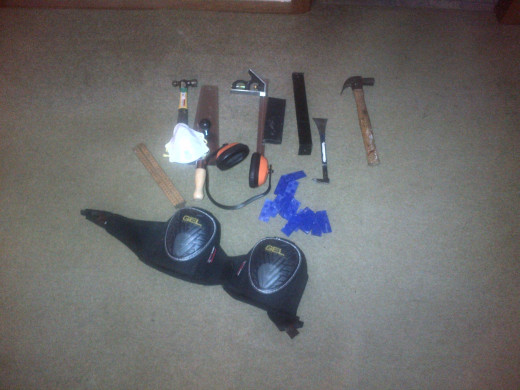
Once the Carpet and Underlay are Both Lifted
Remove the staples from the floor boards. I used pliers for this - see they weren't in the list of tools.
This may take a little while, but it is well worth it. You might need to go over the floor a few times before you get them all. I went over it once, then when I vacuumed the floor afterwards, I found a few more. A little frustrating, but it needs to be done.
Remove Staples
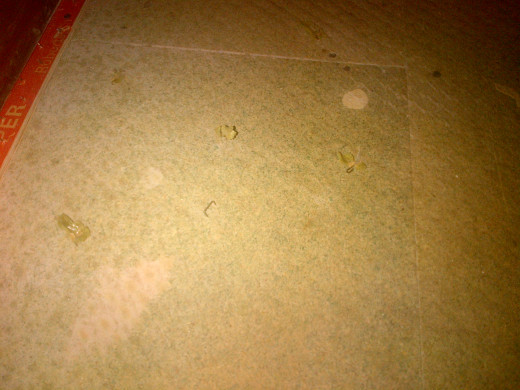
Remove the Gripper Bars
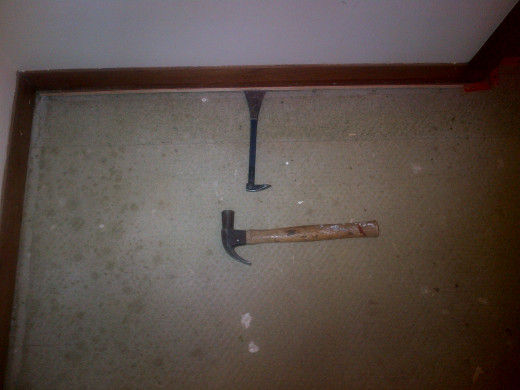
Remove the Gripper Bars
You'll need the pry bar and the claw hammer
Once this is Done
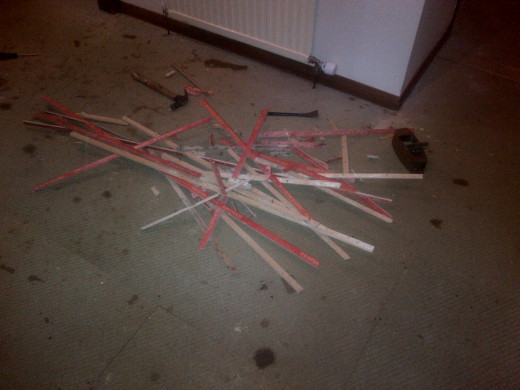
Gripper Bars Removed
You will end up with a heap of gripper bars which are spiky on one side and they will have nails sicking out on the other side. Handle with great care
Gripper Boards
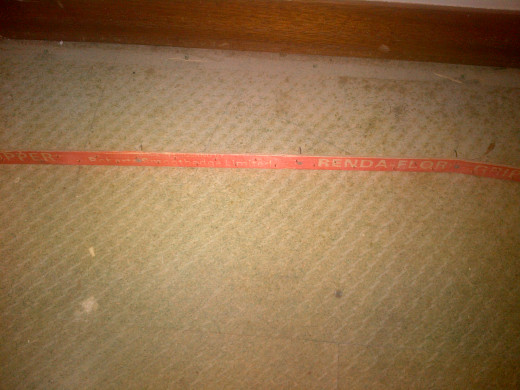
What to do with the Gripper Boards?
I disposed of them in the bin, but they could be reused in another room you are planning on putting down carpet, or give them to someone else. Who knows you could sell them on ebay? Never tried this, but it might be worth a shot.
Next - Remove the Skirting Boards
You'll need the hammer and pry bar for this
Remove the Skirting Boards
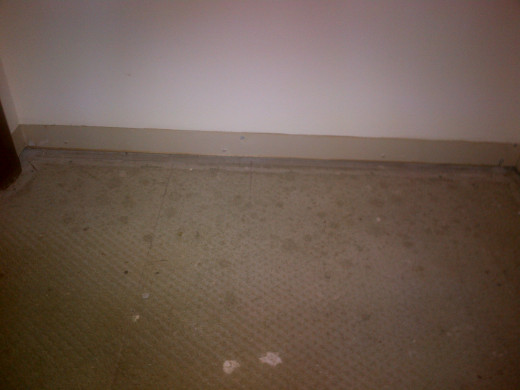
Remove the Nails from the Skirtings
I normally remove all the nails from the back of the skirtings as I will be sticking them back to the wall when all is completed with No Nails or something similar
Good Practice to Label the Skirtings after you Remove Them
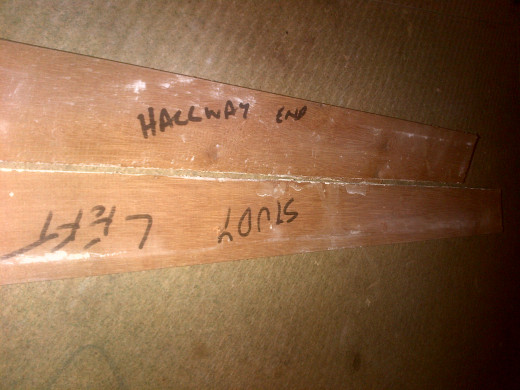
Nails Sometimes Stick in the Walls
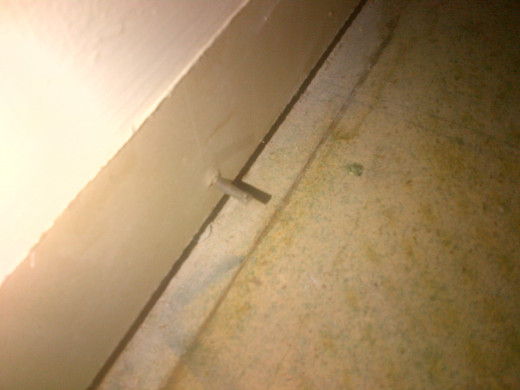
Pull the Nails Out
Pull them out with a claw hammer or the end of a pry bar with nail jaws.
Level the Floor Boards
If there are any parts of the sub-floor which are uneven, these will require to be leveled. This can be done with a plane or chisel. The parts to look at are where the boards join.
The floor should not change in level no more than 2mm in 2 metres.
Tools for Levelling
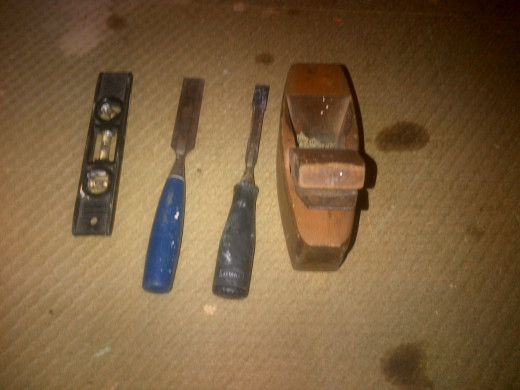
Undercut the Door Frames
The door frames will require to be trimmed as the wooden floor will be higher up than the carpet. There are two ways of doing this - do it with the frames on the wall with an under-cut saw, or take them off and trim them with a tenon saw or jigsaw. I can only recommend the under-cut method. I previously removed the door frames, but it is quite hard to get the length exactly right.
To do this, use an off-cut or a sample of the floor you are about to install and place some underlay underneath it, so that you get the right hight of the new floor. Then use the under-cut saw.
Undercut the Door Frames
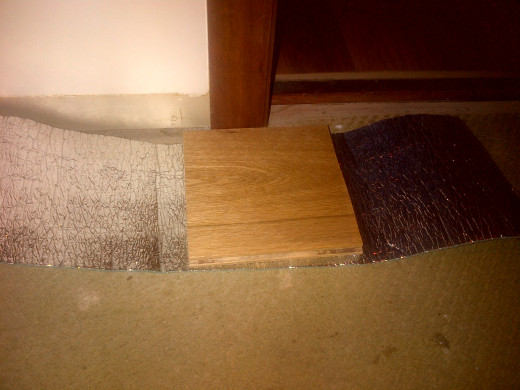
Using an Undercut Saw
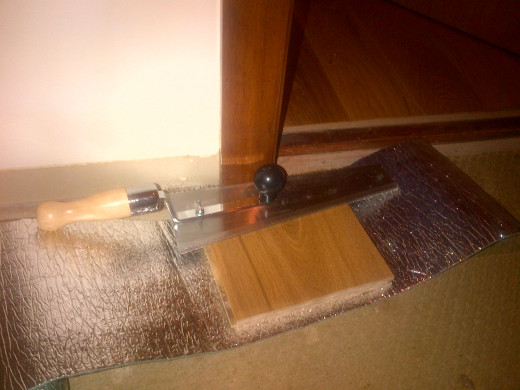
Start Laying the Underlay
Your floor will need a quick vacuum, before you go onto this part, and no doubt you'll find a staple or two which you missed. But once all this is done, it is time to start putting down the underlay.
Start Laying the Underlay
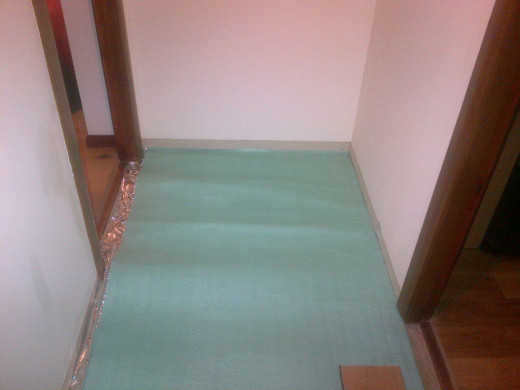
Start Laying the Boards
Place plastic wedge next to the walls where the first plank will go. These will leave a gap between the wall and the floor so that it can expand
The first plank I laid, I had to cut so that it would go into a door space. It is a good idea to use either a flexi-curve or a tiling shape tool to mark the cuts for the door frames - mine are curved at the edge.
Lay the First Plank
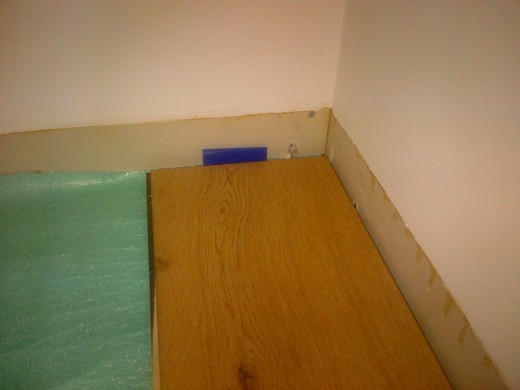
Continue Laying Planks
The next plank you lay will need to be glued to the first plank. Use flooring grade PVA adhesive for this. Put glue on both sides of the tongue.
Glue the end of the Second Plank
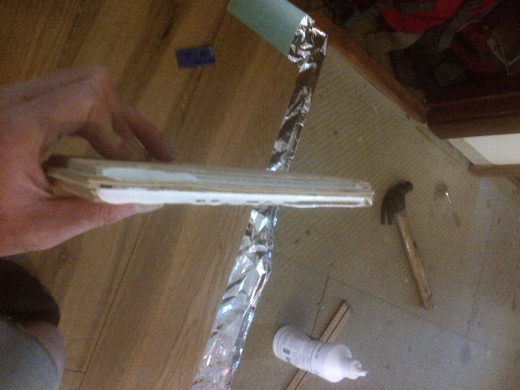
Lay the Second Plank
Once the second plank is cut to fit round any door spaces, lay the plank at the end of the first one, then use a tapping block and hammer to tap the second plank into place. Put plastic wedges along the wall to maintain the gap.
Lay the Second Plank
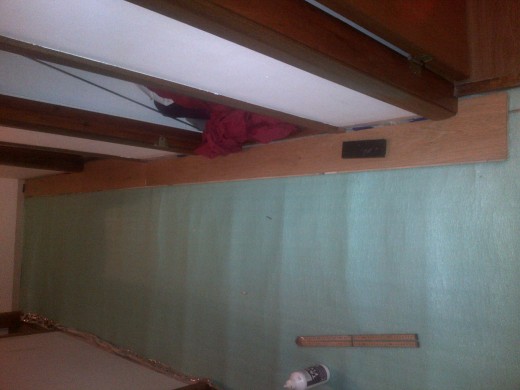
Continue Laying Planks
Continue laying planks until you reach the end of the floor. You will most likely need to cut a plank to size or cut a short piece to fit the last space. Make sure that you cut so that there is still a gap for the spacer at the end.
Third Plank Laid
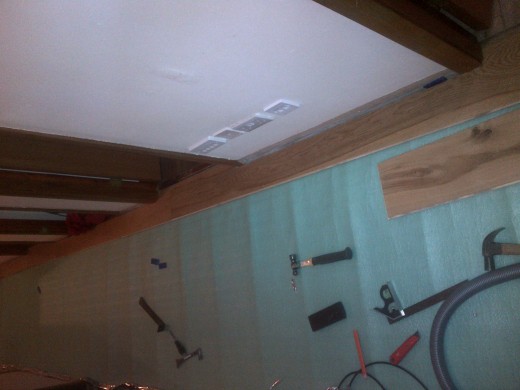
Start on the Second Row
At the beginning of the second row, start with a short plank so that the joins will not all be in the same place.
Put glue along the long edge of the second row planks. It is recommended that the glue should be in lengths of 200mm. So glue for 200mm, then leave a gap of approx 200mm and so and so forth.
Glue the Edges of the Planks
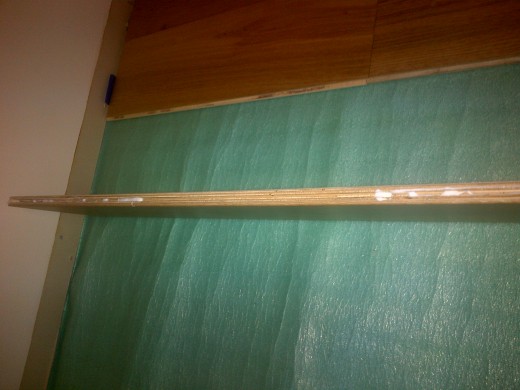
The Second Row Should be Much Easier
At this point, the floor should becoming more stable and will not move around every time you tap new planks into the floor.
Putting a Shot Length at the end
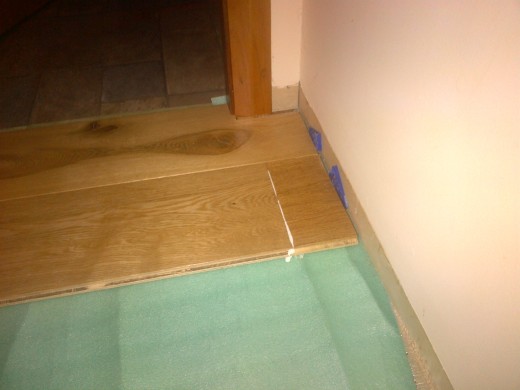
End Pieces
Use the metal S shaped bar to tap in the end pieces. The tapping block will not fit in at the ends.
Using the S Shaped Bar for the Pieces on the end
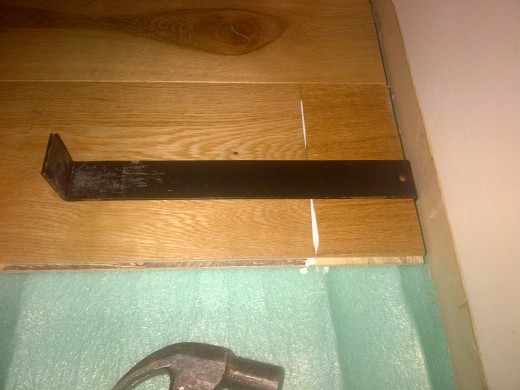
Continue Laying
Continue laying planks. Once you reach the other wall, remember to cut the planks length-wise so that there is enough of a gap to put the spacer wedges in.
This photo below shows how far I reached after 2 days.
After 2 Days
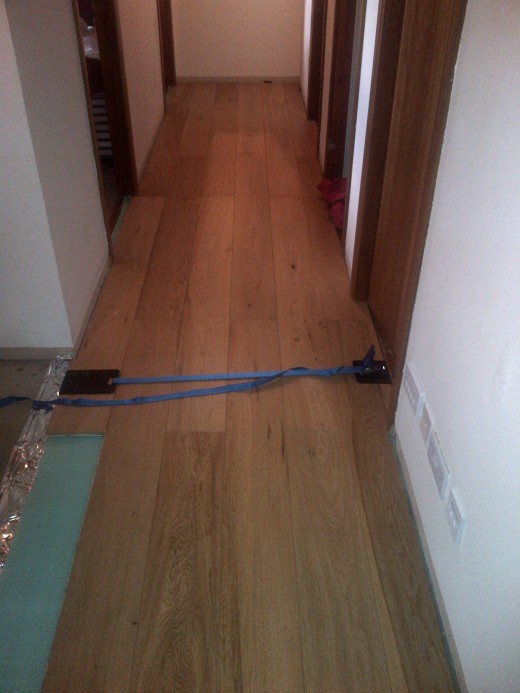
Lay more Underlay
When you have covered the first strip of underlay, you will need to lay some more. Do this before the whole strip is covered. It is good practice to put the new underlay so it overlaps the thin silver edge. I also taped the new underlay down to the existing piece. You can use underlay tape, which is available from most hardware stores, but Selotape is just as effective.
Trim the edges of the underlay with either scissors or a Stanley knife.
Laying More Underlay
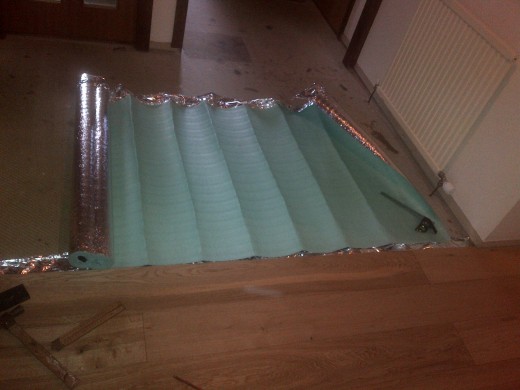
Going Round Corners
At some point you might have to go round a corner. If you are lucky, this can happen by just starting with a new plank, or you might have to cut one to the required shape.
Going Round Corners
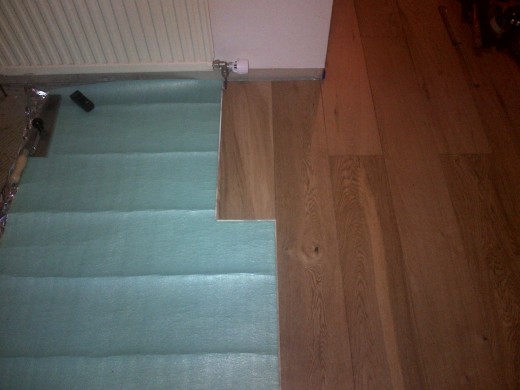
Radiator Cut-Outs
If you have any radiators, you will need to make cut outs for the pipes.
Radiator Cut Out
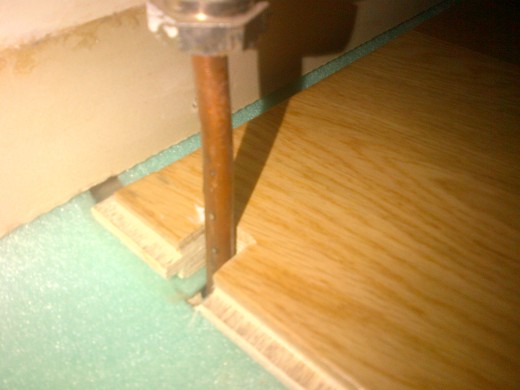
Radiator Cut-Outs
Depending where the cut-outs for the radiator pipes are required, you might need to cut out a small section, then trim this with a tenon saw.
Making a Radiator Cut-Out
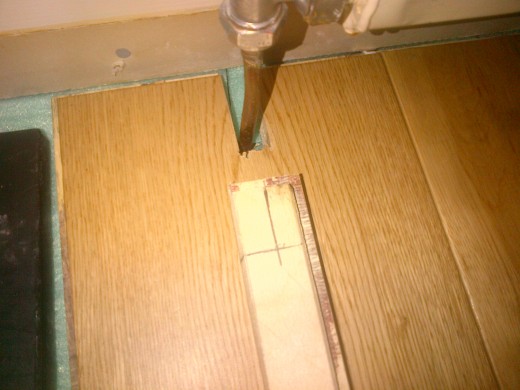
Using a Tenon Saw for the Radiator Cut-Out
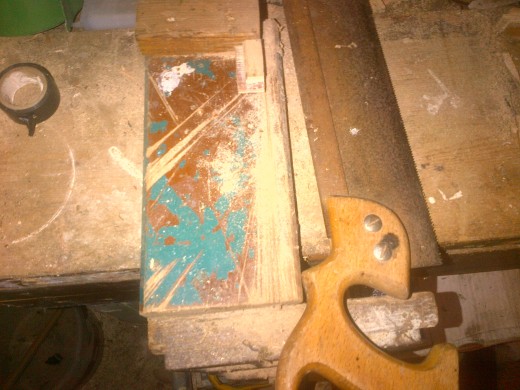
Filling the Gap of a Radiator Cut-Out
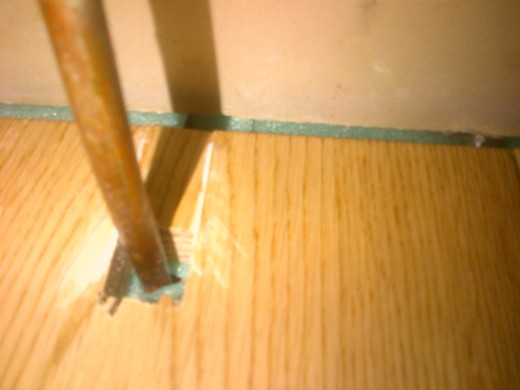
Fitting the Planks Round Obstacles
You might have to do some cuts in the planks which are to fit round obstacles, such as door frames, or walls which stick out. I've shown an example here.
The curves were drawn using a tile shape tool.
Interesting Obstacles
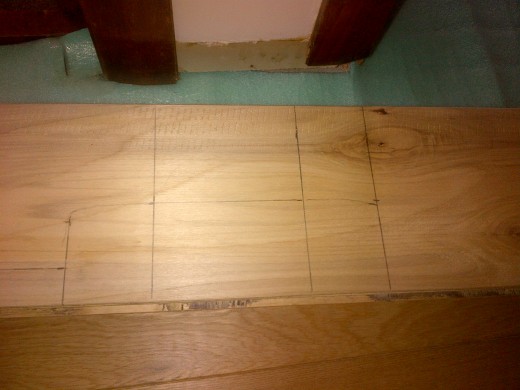
The Process Continues
Continue laying planks until you reach the other end. The process is the same for each plank.
Cut to required length or shape
Check it fits
Glue the tongued edges
Tap the plank into place
Once you are Finished Laying
It is a good point in the proceedings to give the new floor a quick vacuum. There will be sawdust on it and you do not want this to be going all through the rest of the house.
Next Trim the Doors
The next thing to do is to trim the doors.
To do this, put each door back on its hinges and mark the required amount to be removed.
It can take several attempts to do this, so be patient.
I was fortunate in that my doors could be taken off the hinges without unscrewing them - the door attaches to the hinge by means of a plastic clip.
When rehanging a door, it is a good idea to put a dust sheet under it, to prevent scratching the new floor.
I cut the doors with a jigsaw. It was necessary to cut along one side, then turn it over and cut the other side. I then used a plane to smooth out any bumps or any unevenness.
Note that if you do have glass doors, you will need assistance in moving them and rehanging them as they are very heavy.
Trimming the Doors
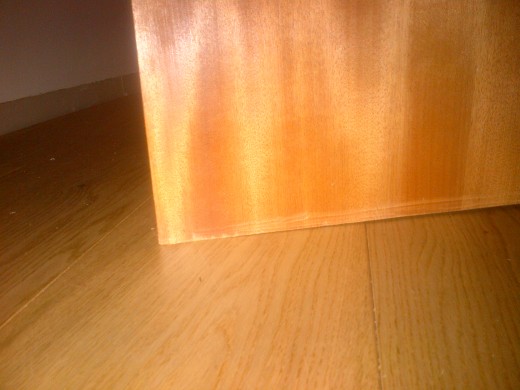
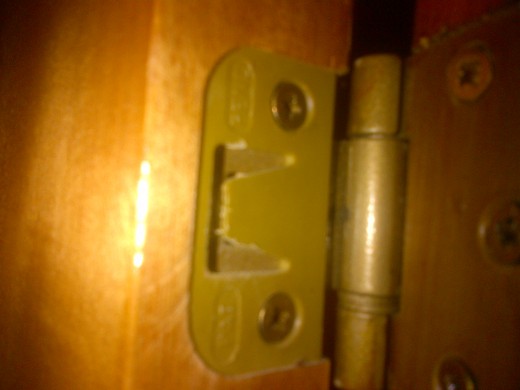
Install any Door Profiles
If you are using any door profiles to plug the gaps between the new floor and the adjacent room's floor covering, you will need to install the door profile.
Some of my doors had a wooden strip at their base, so it was not necessary to do this for every door.
Door Profile Installation
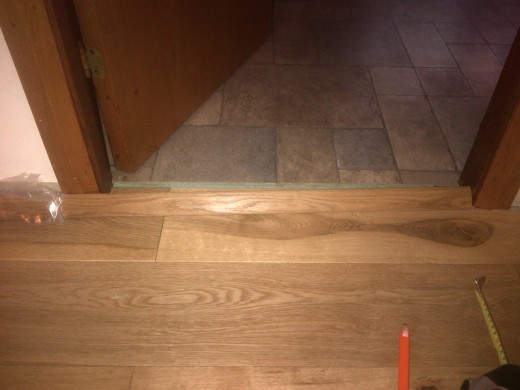
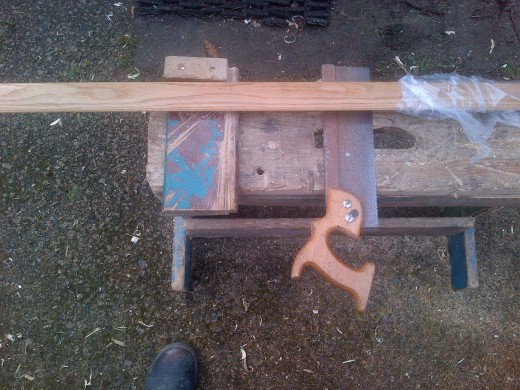
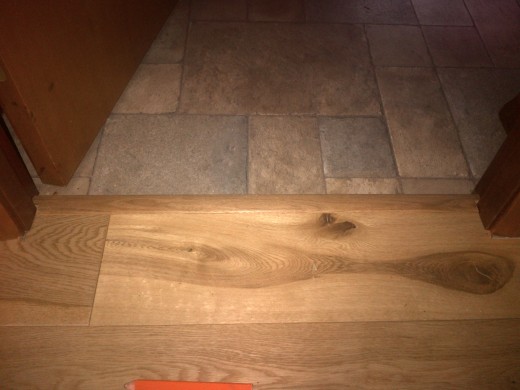
Installation of the Door Profile
Once it is cut to size, you will need to glue the door profile in place, otherwise it will move every time you walk over it.
Next Put the Skirting Boards Back
Once all the doors are trimmed and rehung, and they do not catch on the new floor, it is now time to put the skirting boards back on. My preference here was to rub them down with wet and dry sandpaper, then put 2 coats of stain on them. This took about 3 days before it was complete, but they looked much nicer than before. I did the same for the door frames.
Before I put the skirtings back on, I filled the gaps between the walls and the floor with silicone sealant. This was to draught proof the room.
I used "No Nails" to stick them back on rather than nailing them in to the plasterboard.
The finished Result
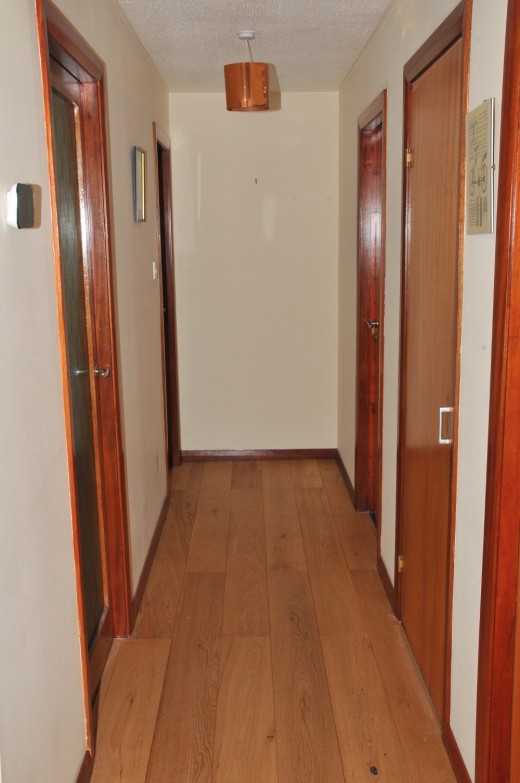
Finishing Touches
To finish the job off, I filled in any gaps between the floor and the bars at the bottom of the doors. I did this with oak coloured sealant.

